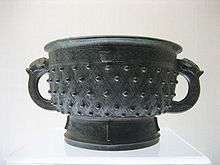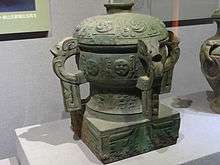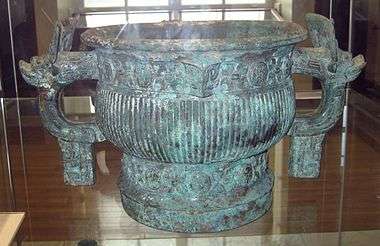Gui (vessel)
| Gui | |||||||||||||||||
| Chinese | 簋 | ||||||||||||||||
|---|---|---|---|---|---|---|---|---|---|---|---|---|---|---|---|---|---|
| |||||||||||||||||



A gui is a type of bowl-shaped ancient Chinese ritual bronze vessel used to hold offerings of food, probably mainly grain, for ancestral tombs. As with other shapes, the ritual bronzes followed early pottery versions for domestic use, and were recalled in later art in both metal, pottery, and sometimes stone. The shape changed somewhat over the centuries but constant characteristics are a circular form (seen from above), with a rounded, wide, profile or shape from the side, standing on a narrower rim or foot. There are usually two, or sometimes four, handles, and there may be a cover or a square base (or both).
The Kang Hou Gui, an 11th-century BC example in the British Museum was chosen as object 23 in the A History of the World in 100 Objects.[3]
The British Museum bowl inscription on the inside of the bowl tells that King Wu's brother, Kang Hou, who was the Duke of Kang and Mei Situ were given territory in Wei. The inscription relates a rebellion by remnants of the Shang, and its defeat by the Zhou, which helps us to date it. Because historians know exactly when this unsuccessful rebellion against the Zhou dynasty took place then the bowl can be dated very accurately.[4]
References
- ↑ British Museum Collection
- ↑ British Museum Highlights
- ↑ "Chinese Zhou ritual vessel (gui)" at the British Museum, #23 of A History of the World in 100 Objects, accessed February 2012
- ↑ "Chinese Zhou ritual vessel" more from the BBC on the same Gui from the British Museum
- "gui." Encyclopædia Britannica Online. Encyclopædia Britannica Inc., 2012. 06 Feb. 2012.
- Rawson, Jessica, et al. "China, §VI: Bronzes." In Grove Art Online. Oxford Art Online, (accessed February 7, 2012; subscription required).
- Sing, Yu; Caron Smith (1999). Ringing Thunder- Tomb Treasures from Ancient China. San Diego: San Diego Museum of Art. ISBN 0-937108-24-3.
Further reading
- Fong, Wen (ed.) (1980). The great bronze age of China: an exhibition from the People's Republic of China. New York: The Metropolitan Museum of Art. ISBN 0870992260.
External links
-
 Media related to Gui (vessel) at Wikimedia Commons
Media related to Gui (vessel) at Wikimedia Commons - The development of the Gui, illustrated by examples in the collection of the Metropolitan Museum of Art:
- 12th century B.C., Shang dynasty
- 12th–11th century B.C., Shang dynasty
- late 11th–early 10th century B.C., Western Zhou
- early 9th century B.C., Western Zhou